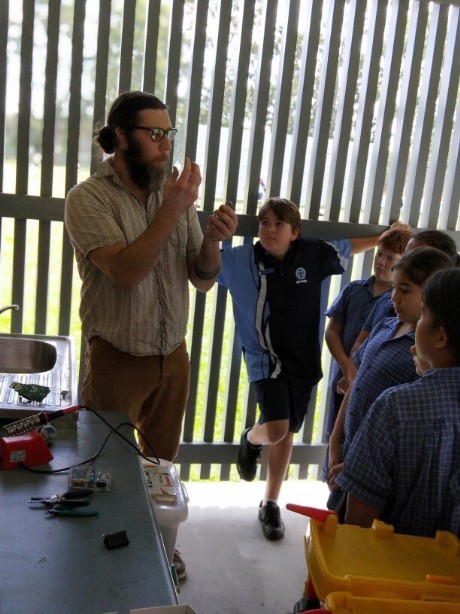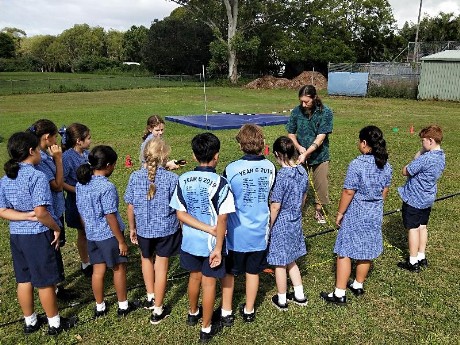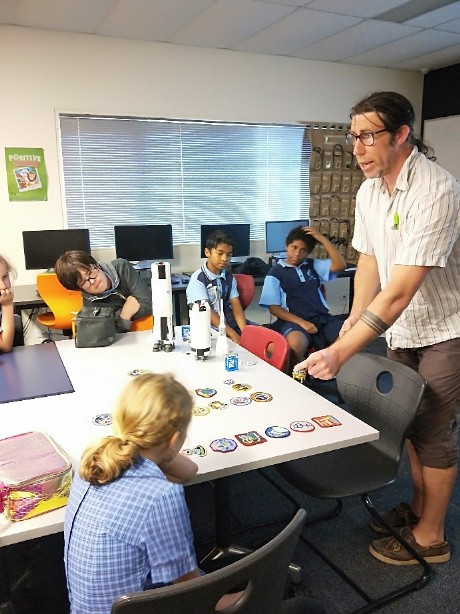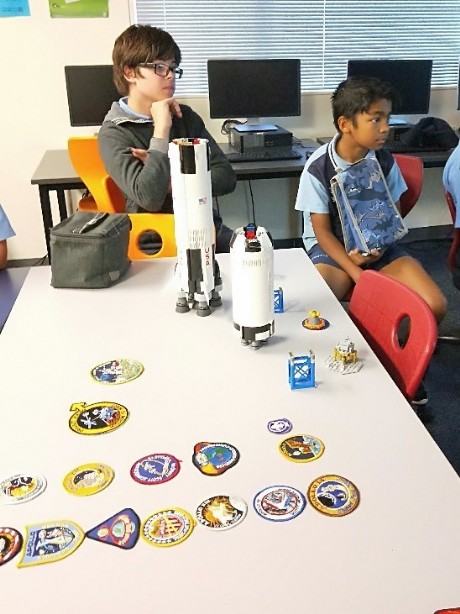News Page 5
This page contains all the latest news about school amateur radio clubs. Please contact us to add your SARC news to this page. Send us a picture and description of your SARC activities. Remember to get parental permission to publish student photographs on this site and in our newsletters.
Northgate State School Radio Club
The latest member of SARCNET is Northgate State School, in Nundah Queensland Australia, run by Matt Hesse VK4PZZ.
We though we would tell the amazing story of Matt and his radio club kids in their own words so that it might inspire others to do the same.
"G’day
My name is Matt Hesse VK4PZZ and I’m a Scout leader and a Dad of a primary school kid. I just would like to let you know that you guys have inspired me to ask some questions at our school and at my scout den about sharing radio with kids. The result of this is that I now have 4 scouts with foundation calls and a radio room with a club call sign on the way. As well as being involved with a STEM week in term 3 and a proposed radio club term 4 at the school. Your website is fantastic, thanks very much. Could I ask if you have any words of advice you may be able to pass on before I start.
Cheers 73, Matt Hesse, VK3PZZ"
"Hi Matt,
Thank you for your kind words, but all the credit goes to you for taking the initiative! What you have achieved is nothing short of spectacular. We absolutely encourage you to keep at it and we hope we can provide any assistance that you need. There are so many things we could advise about approaching a primary school and running a SARC program. However, the main thing is to start simple and to develop a close working relationship with school staff. Our golden rule is that: "It is all about the kids and what they can do". They just love having their own radio club. It may not be easy, but we can tell you that the rewards for getting young kids into radio and electronics are worth every effort, time and expense. If you would like to talk more about the process, please feel free to contact us.
Kind regards, Julie VK3FOWL and Joe VK3YSP"
"G’day Julie and Joe, I am just wanting to share with you that I had a very successful experience with my school radio club. Over 8 weeks I took two groups of year 4 kids through a basic introduction to handy talkies and UHF VHF commutations. Out of the 16 who signed up only 4 were boys, which I thought was very interesting and great to see that girls are wanting to have a go.
So this year, since it’s the 50th anniversary of the moon landing and because I’m also personally interested in satellites, we are going to make your satellite tracker. Could I ask how you went about making it with your groups and what time frame it took you. Or did you make the tracker and then let the kids play with it? I’m looking at making a couple with my Scout program and hopefully offer it to any den interested in the idea. Thanks again for your amazing work and for sharing all you ideas.
Cheers, Matt Hesse, VK4PZZ."
"Hi Matt,
First of all congratulations on setting up and running a your own School Amateur Radio Club. If only we could encourage more like you to do the same! If you would like to join our School Amateur Radio Club Network and help us do just that please let us know. If so we would:
• Add a description of your school club, including pictures of your students (with parental permission) to the schools page on our website.• Collaborate on specific activities, missions and projects of interest to you.• Include news items of your achievements to encourage others.• Help you expand your operations at school. Maybe even setup for HF and organise a QSO with our kids!• Help you promote your club to the wider AR and education community.
It is excellent that you encourage the girls, because they get so few opportunities to experience STEM. And of course they are bright as buttons!
Isn’t it amazing that it is 50 years on since man first walked on the moon! Satellites are a way for our students to “touch space”. It is always amazing to us when they ask: “Where is the satellite?” and we point along the Yagi boom and say “up there”.
A few things to know about our Mini Satellite-Antenna Rotator project before getting started:
• Over 500 have been built around the world.• It is an ambitious project: Many have struggled sourcing the right components, machining the enclosure, following all the steps and calibrating the sensor.• Together with a tripod, Arrow antenna, battery, controller laptop, it takes an hour to set up. Outside, in the playground, it is difficult to view the PC screen.• Good AR satellite passes, with OMs to QSO with, almost never occur during school lunchtimes.• There are plenty of other satellites to track and “listen” to. Some have data modes and decoding software. You can setup to receive NOAA and METEOR satellite pictures on 137MHz.• The Arrow antenna is linearly polarised. Even with the tracker working you get deep polarisation fades. RHCP Antennas are more ambitious.• When your class does manage to listen or talk to something in orbit with their own equipment it is a major, newsworthy achievement for all involved.
For over a year now we have been working on our new SARCTRAC project. A complete stand-alone tracker unit. It is nearly ready for release. As you are the first Australian SARC following our model we are tempted to donate a working unit or a kit of parts to your club. See our Projects page for details. In the meantime, may we suggest that your students get some electronics kit construction and lead-free soldering skills! All the information for that is on our Workshop page.
Kind Regards, Julie VK3FOWL and Joe VK3YSP."
"G’day again,
Yes I would personally love to join SARCNET. I really think it has a lot to offer for my own knowledge and the next generation.
I have asked for permission from the School and am waiting to hear back from them. The STEM coordinator is very encouraging of the ideas I have shared with her so far.
Thanks again, Matt Hesse, VK4PZZ"
Claudia, Banbha, Matilda (Year 5) write: "We have been learning to make circuits ourselves, learnt what parts are on a circuit board and studied how to speak fluently on the radio. It has been quite a lot of fun. We learnt Morse Code at the beginning of the term. Morse Code is a form of communication using dots and dashes or long sounds and short sounds. This week we learnt how to navigate using a grid reference and walkie talkie while we were locating special objects hidden around the school. We also learnt how important it is to speak clearly o the walkie talkies. And, if something happens like your battery runs out or you loose signal: HEAD BACK TO BASE! We have loved all the activities Radio Club has to offer and wish we could do it all year round."
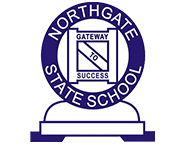
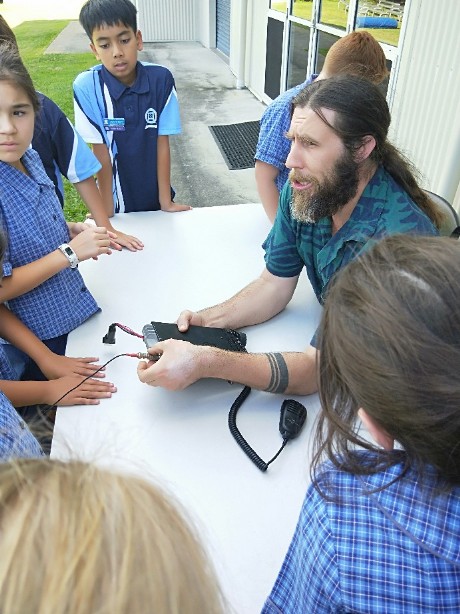
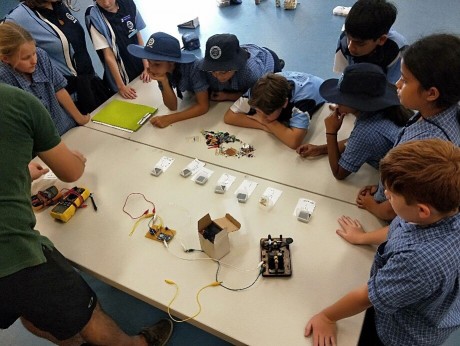
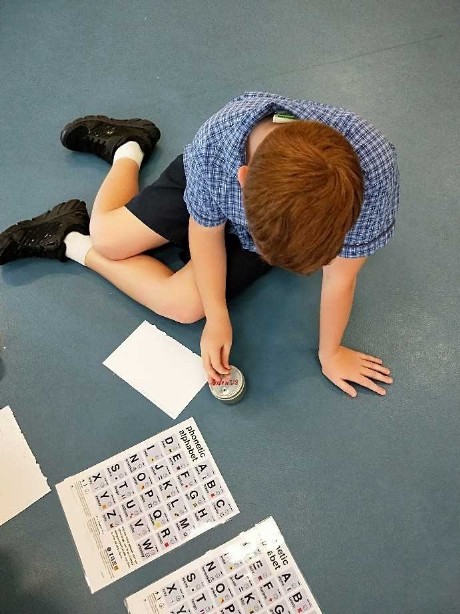
"Hi again Matt,
We are both excited to see how you progress with this and are more than willing to provide any assistance we can. Here is a summary of our recent telephone conversation:
Your idea was to set up a lunchtime radio club for half an hour per week, for term 4. You have handheld radios, scouting experience and fox-hunting gear, like tape yagis and crystal-locked VHF beacons.
We discussed the importance of:
- Keeping it simple (an example only):
- Just start with a couple of handhelds.
- Explain they will be learning about emergency radio communications that could save their lives one day.
- Tell a story about some people who got lost and were saved because they knew what radios, frequencies and procedures to use.
- They just need to practice keeping calm, cooperating with one-another, speaking clearly and describing an emergency situation
- Others can write down what was said for a report and can think up the most important questions to ask on the air.
- How many are injured? How serious the injuries? How soon is help required? Do they have shelter and water?
- This may prompt a discussion on what you should bring and do when going hiking in the wilderness.
- The effectiveness of the operation can be triaged later and you can repeat the activity next week.
- The teacher can suggest a class follow up activity. You might find the whole class attends next time.
- Ask them to describe their position with reference to other land marks, distances and cardinal directions.
- Get on a quiet channel on the amateur band.
- Don’t worry too much initially about calling procedures, just announce your call and what you are doing every so often.
- Don’t use MAYDAY or PAN on air. Instead just announce it is a simulated emergency event.
- The focus is on each and every child getting a go of the radio and plenty of praise for using the equipment well.
- A realistic story and activity should give them plenty to think about. Careful, though, some may be easily upset by emergency situations.
- Not burning yourself out:
- Don’t try to do too much in a 30-minute session.
- You actually will only get 20 minutes.
- Plan just one activity well.
- Ask the teacher to get the kids quiet and started on time. Request assistance when they are not paying attention.
- Don’t get upset if it all turns to custard... There will be other opportunities.
- Getting teachers on side by:
- Introductions to the principal.
- Enlisting teacher support and participation.
- Asking about their curriculum needs and something called key learning outcomes.
- Explain to them it is a joint effort because they know how to teach and you have all the resources needed for the lesson.
- Pointing out the wide range of STEM activities supported by Amateur Radio (show them our web site for more ideas).
- Pointing out the key STEM concepts: Radio waves (are everywhere), frequency (VHF), propagation (LOS), signal strength, sound, batteries.
- Radio Communications: Different from mobile phones: Separate RX/TX on one channel. Reliable: Does not need but can use fixed infrastructure.
- Providing the class with an introduction, summary and review questions. What to think about at home prior to the next session.
- Letting teachers participate, giving them kudos for correct responses, even suggesting how easy it is to get a foundation licence themselves.
- Bounce any directives for the kids off the teachers by looking at them and engaging their cooperation e.g. when splitting up into groups.
- Practical things:
- Handhelds: The more the merrier. Fresh batteries. Locked keyboard. A short introduction to the group about controls and displays.
- Care and use of radio equipment. Lanyards. Antenna cable strain relief. No running.
- Give each group a different card describing their specific emergency situation (they will have trouble thinking them up).
- 100% teacher supervision is required.
- Check:
- Working with children card.
- Covered by school’s public liability insurance.
- Special needs students and how to handle them.
- First aid and injury response.
- How to segregate the groups during school lunchtimes.
- Handheld VHF radio equipment is safe to use in accordance with ARPANSA standard: "Radiation Protection Standard Maximum Exposure Levels to Radiofrequency Fields — 3 kHz to 300 GHz".
- These are all good things to discuss with the principal to show you are prepared.
That’s all for now Matt. Keep in touch. 73, Julie VK3FOWL and Joe VK3YSP."
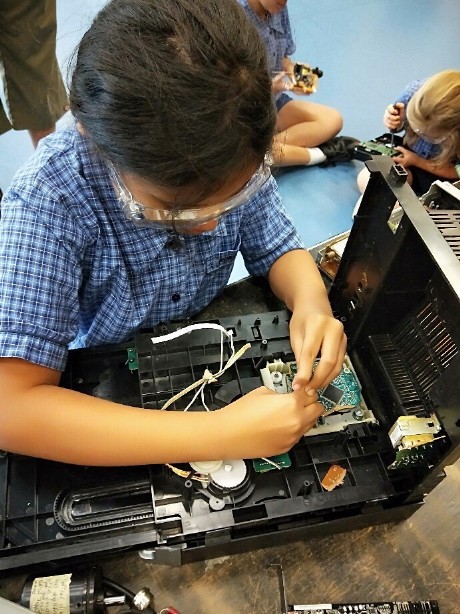
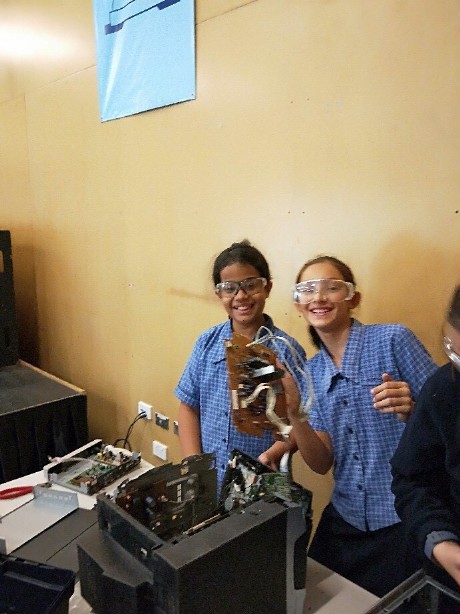
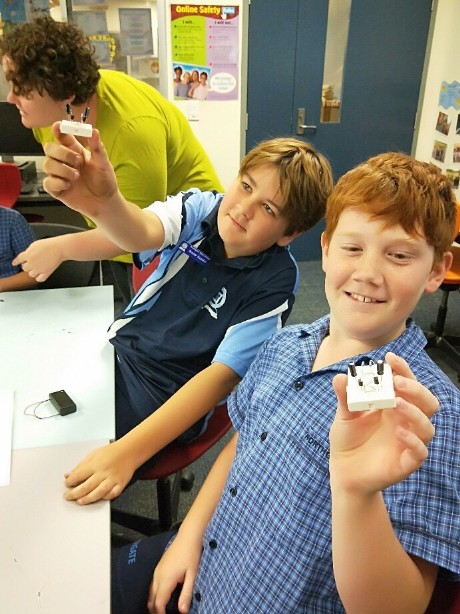
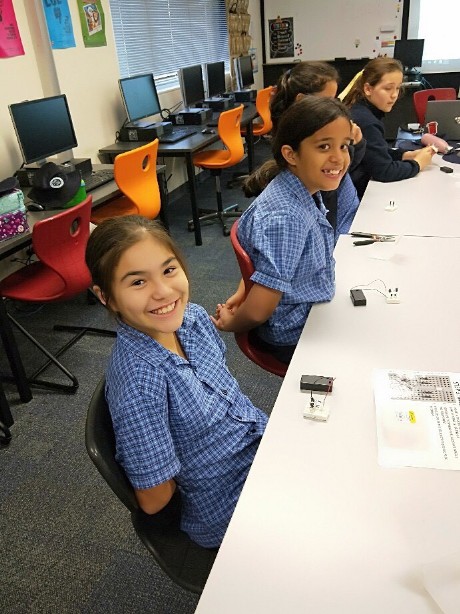
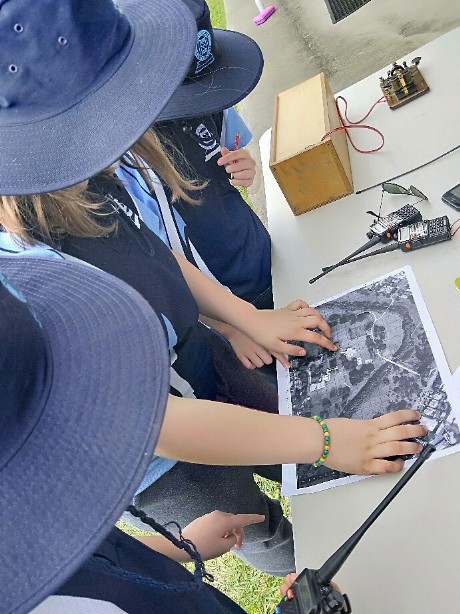
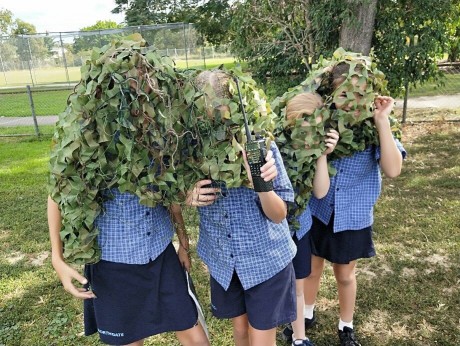
"G'day Julie and Joe,
Starting in term 2 we will have 31 students participating. Split into two groups each having 8 weeks of program. We are an enthusiastic group that enjoy having fun and learning by stealth. We meet one lunchtime a week to explore amateur radio and how it relates to topics included in the STEM program. I am really impressed with the kids I have in my radio club. I didn't have to speak to them about behavior or anything they just wanted to be involved. As promised I have attached some photos and will be getting the kids to write a article shortly.
The kids thought the squid pole was a magic trick. I use my SOTA beam linked dipole and the kids had no problem setting it up. I have attached the program.
Cheers, Matt Hesse, VK4ZPP"
OMG! That is absolutely fantastic Matt!
You and Northgate School Amateur Radio Club rock!
We will publish a special news article on the club and Claudia, Banbha, Matilda's report on our website ASAP.
Congratulations mate, you are leading the way and have made us very proud!
Let us spread the word: This is how to get kids interested in STEM!
Good job. Kind regards, Julie VK3FOWL and Joe VK3YSP.
"Hi Julie and Joe,
Just wanted to say we have started a new group. We focused on the 50th anniversary of Apollo 11 and how comms were a major part of the mission. We also hear how good communication is fundamental to success.
Cheers, Matt Hesse, VK4ZPP"
